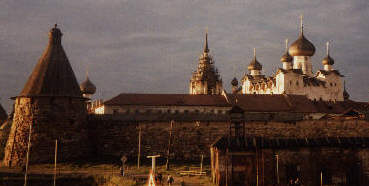| The Solovets Islands belonged
to Novgorod, which sent the first three monks to the monastery. After the
fall of Novgorod in 1478, the monastery changed ownership and fell to the
state of Moscow. It grew especially intensively under the leadership of
St. Zosima (1452 - 1478) and developed in economic terms under Abbot Filip
(1548 - 1566) who later became the Metropolit of Moscow. During the second
half of the 15th century, the monastery owned large tracts of land and fishing
grounds along the White Sea Coast as well as salt mines which allowed the
monastery to involve itself in profitable trade throughout the entire realm
of Muscovy. The abbots even built their own rope-factory for their fleet
on the White Sea and on the northern rivers. The monastery also served as
a border fortress which successfully defended itself against attacks from
the Swedes in 1571, 1582 and 1611.
In the context of the reforms of Patriarch Nikon and the Raskol
during the second half of the 17th century, the Solovets monastery played
an important role. In July of 1657, the monks refused newly printed books
because of "blasphemous heresy and malicious changes". The monastery revolted.
The monks also refused to recognize the decision of the Sobor (council)
of May 13th which definitively confirmed the reforms and placed a ban
on all who refused to recognize them. In the end, the government decided
to supress the revolt. In January of 1676, after seven years of siege,
it ordered the monastery to be taken by storm. Many monks were killed,
while others were able to flee into the woods to become the leaders of
the Raskol movement.
The monastery was closed by the Bolsheviki in 1920.
Kristina Kühne
The History of the Solovets Concentration
Camp
In 1923, a "Camp for Special
Purposes" (SLON) was opened on the territory of the Solovets monastery.
SLON was the prototype for the GULAG which later became widespread throughout
all of Russia.
The history of the Solovets
"Camp for Special Purposes" can be divided into three periods.
The first period (1923-1929)
was connected with the formation of the camp, with the development of
repressive methods and with the rapid economic development of the archipel
itself. This phase of the camp's history was almost completely uncontrolled;
almost everything depended on the mood and the character of the camp's
commandant. During this period, there was an amateur theater-group and
an ethnographic club in which prisoners could develop their interest in
the history and the culture of the region. At the same time, the conditions
in the camp were absolutely arbitrary and lawless.
The second period (1929-1937)
began after an inspection through a commission from Moscow which was headed
by A.M. Shanin, an employee of the OGPU (Ministry of State and Secret
Police). This commission was able to tame the "educators" at the camp
for a short time; several notorious prison-guards were shot. However,
the ethnographic club was liquidated during this period. The newpaper
and journal which the inmates published were also prohibited.
During the 1930s, the ambitious
plan for the industrialization of the Soviet Union demanded cheap labor
which could even be sent to the country's most hostile regions without
difficulty. Consequently, the Solovets archipel became a section of the
BelBaltLag whose role, among other things, was to secure the construction
of the White Sea Canal (Belamor kanal). Many inmates were transferred
to where workers were most needed, to Karelia, to the Kola peninsula or
to Vaigatsh.
The third period began in the
summer of 1937. Next to the camp, the Solovets Prison for Special Purpose
(STON) was opened for political prisoners. "Enemies of the state" ("spies"
and "parasites") were interned here. From then on, inmates of the camp
no longer knew what went on behind the walls of the monastery.
In the summer of 1937, the
thousands of political prisoner were disallowed any written contact with
their relatives. Later, the relatives of the prisoners were sent notices
which told them that their interned relatives had died of pneumonia, cancer
of the liver or heart disease in 1941 or 1942. In reality, they were all
shot in groups during October and November of 1937. During the summer
of 1939, the inmates were brought to Norilsk, Vorkuta and to prisons in
Central Russia in the holds of cargo ships and steam-boats. Toward the
end of December, the last steam-boat left Solovki, ending the history
of the Solovets Camp for Special Purposes. Famous writers, historians,
philosophers and scientists were interned at Solovki. These included the
theologist P. Florenski, the dramaturgist and theater-director A.S. Kurbas,
the poet and scholar G. Kusebai, the ethnographist N.N. Vinogradov, the
cultural historian D.S. Likhachov, the zoologist A. Sakhvatkin and many,
many others.
Jekaterina Malamutmann
|

